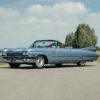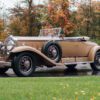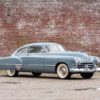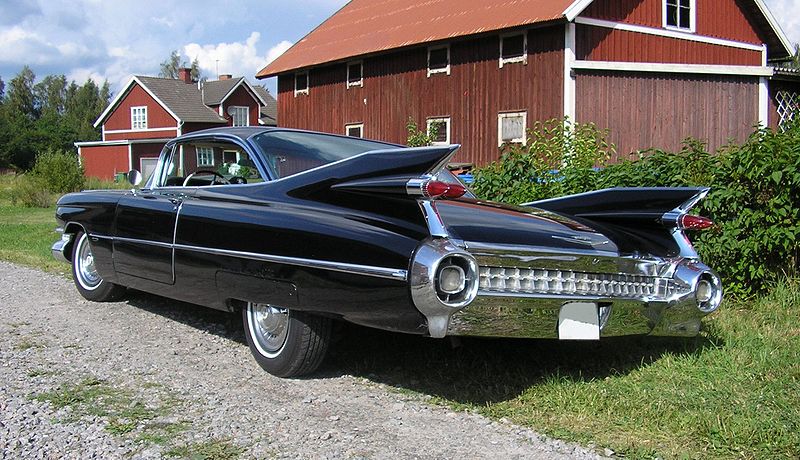Cadillac Models & History 1959
The’59 Caddy had it all — looks, performance, and comfort. It stood as the ultimate symbol of success, impressive and — yes — controversial. The outrageous tail fins and jet pod taillights evoked either a love it or leave it attitude with the public. It is interesting to note that Maurice D. Hendry,

author of Cadillac: Standard of the World, The Complete Seventy-Year History, refused to include a picture of the regular production ’59 Cadillac in his book. He said that, “This year saw the tail fins reach a literally ridiculous height…. The fins had plenty of critics including this writer…. Nevertheless, the 1959s overall were excellent…. As cars — rocket fins or not — they were undeniably excellent.”
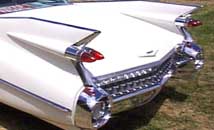
Walter M. P. McCall, in 80 Years of Cadillac-LaSalle agreed, commenting that the 1948 tailfins “soon became Cadillac’s most famous styling feature, but with each successive series of new cars these rear fender appendages grew higher and more flamboyant. By the late 1950s they had reached ludicrous proportions and were of questionable taste.” He called them “Cadillac’s spectacular ‘zap’ fins!” Up front, McCall observed that “The new grille was a glittering cliff of chrome. And as if one toothy grille wasn’t enough there was even a dummy grille across the lower rear deck of most models. A thin, horizontal blade divided the jeweled front grille into upper and lower sections. Parking and turn signal lights were paired in pods at the outer ends of the massive new front bumper. The new rear bumper had huge, chrome outer pods with backup lights recessed in their centers.”

Of course, just about everybody knows about the monster fins on the ’59 Cadillac. But how many have ever heard about the Cadillac designed around a Buick door? The 1959 Cadillac was. General Motors had gone through three expensive years of tooling up for new models and the head honchos wanted to trim costs. They decided to make the basic Buick front door a common interchangeable element throughout the GM C-body line. This was a tough directive because the door tapered rearward, but an order was an order and the Cadillac design team worked around it, turning out an unforgettable product in the process.

Dave Hols, now Director of Design with the General Motors Design Staff, was a designer at the Cadillac styling studio in 1956. He remembers the Buick door challenge quite well. “Boy, did you guys see those ’57s parked down at the end of Mound Road?,” Hols recalls one designer asking as he came into the studio one morning. The designer was referring to the befinned 1957 Chrysler cars. Actually, Cadillac had started the great automotive fins race in 1948 after styling chief Harley Earl had sent a group of designers out to Selfridge Field near Detroit to study a Lockheed Lightening P-38, particularly its rear stabilizers. Now, almost a decade later, Chrysler’s cars were out-finning Cadillac — and in a bold way at that. In point of fact, Chrysler had temporarily wrested design leadership from GM, and that could not be tolerated.
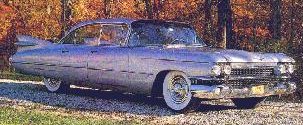
Thus, Chrysler’s challenge set the Cadillac design team’s creative course — the ’59 Cadillac was going to have flamboyant fins. All the designers were disenchanted (some to the point of hate) with the ’58 Caddy and they were going to abandon most of its design themes. And just as the 1958 Lincoln and Continental Mark III set out to “out-Cadillac” Cadillac in 1958, Cadillac found itself in the curious situation of trying to “out-Chrysler” Chrysler in 1959!
1959 Cadillac
Retired Vice-President of Design, Bill Mitchell, remembers the battle with Chrysler. “I think what happened is that at the time [Virgil] Exner at Chrysler and we at GM tried to out-fin each other. I think the worst year we had was ’58 when we were putting on chrome with a trowel. We had chrome on everything, and in ’59 we tried to out-fin Exner. You know, we went on to ’60 and ’61 and brought the fins down and made them a little more sane — a little more ‘sanitary.'”
1959 Cadillac
The head of GM styling at the time was Harley Earl, the Father of modern automotive design. But he was away in Europe when this inspiration came to the Cadillac design staff. “When the cat’s away….”

Every designer on the project was enamored of jet aircraft. It was nothing to see a stack of books on the subject on their desks. This was an exciting time in aviation and the designers were awed by the shapes of the latest jets. True, the P-38 influence continued on the ’59 Cadillac with the flow-through lines. As Mitchell said, “Seeing the P-38, you saw how you could go from the headlight straight back to the tailfin in one line.” But, as Hols puts it, “By the mid-Fifties, jet aircraft were the thing.” If you look at the rear of the ’59 Caddy, it looks like the exhaust ports of a jet. It’s no wonder the ’59 Caddy looks like it’s really moving even when it’s just sitting in the driveway.
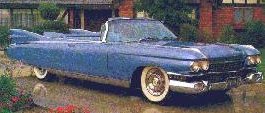
All the right ingredients came together for the creation of the ’59 Cadillac. First, GM was doing all-new vehicles for 1959. Second, the taper in the Buick door dictated Cadillac’s rearward taper. Finally, Ed Glowacke, head of design at Cadillac, wanted a new, innovative, state-of-the-art design. Cadillac could do nothing less than Chrysler and still be competitive, Glowacke thought. So he put his crew on a rush schedule to get the 1959 design completed. Work began about October 1956, with the car set for an October 1958 introduction. Compared to other GM design time-tables, that was incredibly fast and meant many late hours in the studio.
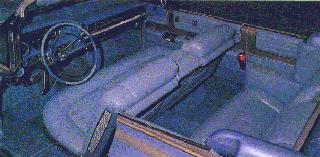
Dave Hols, working with Glowacke and crew, developed the distinctive tailfin design. Twin taillights were used because twice as many looked more expensive. Thus, nacelles were designed into the tailfins to allow for them. Chuck Puhlman and Roy Hill also worked on the design. In the end, use of the Buick door cost more than originally projected, mainly because of the taper and drop in height. Without that taper, however, the car’s lines wouldn’t have carried the characteristic sweep of motion that became such a distinctive part of the car’s design — and certainly we would not have seen those huge fins.
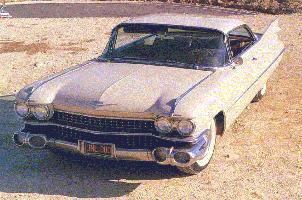
One of the most striking impressions one receives from inside the ’59 Cadillac is a marvelous feeling of openness. That’s because 1959 was also the “greenhouse year” at GM. The entire lineup boasted unexcelled visibility compliments of the thin pillars and abbreviated sail panel (really only a pillar itself). Sitting in the car, the driver could easily see all four corners and enjoy an almost unobstructed view in all directions. Part of the increase in visibility had to do with the design of the roof. In fact, the buyer could choose from two distinctive roof designs, the first a more traditional curved roof, the second a radical “blade-upper” flat roof. Both lent themselves to creating lavish vistas of visibility.

Interior planning for the 1959 Cadillac, including the Eldorado Brougham and limos, was directed by Bob Scheelk, head of Cadillac interior design. He remembers the project as a rush program; he was asked to have the instrument panel in clay — with working instrument lights — for the GM Board of Directors at the Tech Center in the spring of 1957, a monumental task. As it turned out, the executives approved the instrument panel for production pretty much as presented. It was quite deep because of the depth of the cowl and the rake of the wraparound windshield, which resulted in an extended shelf. Also working on the interior were Sue Vanderbilt (who had worked on Cadillac exteriors earlier); Russ Bolt, a studio engineer; and two clay modelers.
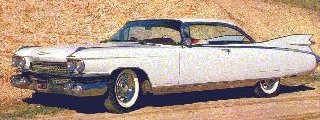
Of course, Cadillac shared a number of parts with other GM cars, mainly the structural pieces hidden from view. Cadillac’s interior also shared components with its GM siblings — items like door moldings and openings, window surrounds, and seat frames. But most of what the buyer saw, including the seat cushions and fabrics, was unique.

1959 Cadillac
The extreme curvature of the windshield caused some rethinking regarding placement of controls and switches. For example, the section of the dash which curved around on the driver’s side to the door opening was large enough that the designers referred to it as the “horn.” On it, they placed the windshield-wiper controls and the power window switches. Originally, the cruise control was located there, too, but it had to be moved because it conflicted with the other controls.
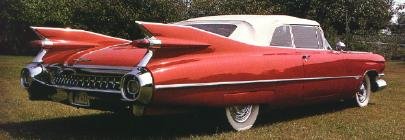
1959 Cadillac
Because so many components were new, even the door opening mechanism for example, extra care had to be taken to maintain Cadillac’s reputation for high quality. One problem in this regard was the metallic fabric used on the Fleetwood Sixty Special; it trapped the guard-hairs of women’s mink coats when they sat down and hung onto the hairs when they got up. This textile problem was rapidly addressed and solved.

Scheelk came up with the colors, had some cars painted, and hosted an outdoor color show for management at Cadillac engineering on Clark Street. There, a vote was taken. Only after the formulas for the selected colors were developed and the problems worked out did the colors receive final approval. Cadillac often boasted about its Magic-Mirror acrylic lacquer finish.
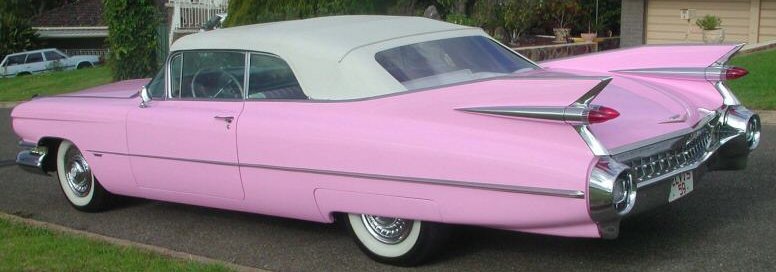
All 1959-60 Cadillacs came with Hydra-Matic, power steering, and power brakes as standard. They also featured a new direct-acting power brake booster and automatic-release parking brake. Of course, there was a long list of options: cruise control, air suspension (whose shocks now contained plastic bags of inert Freon-12 so that the gas could not mix with the shock absorber fluid), electric door locks, Autronic Eye headlight dimmer, power windows and seat, air, E-Z Eye glass, power trunk with pull-down, and more.

The ’59 Caddy rode a 3302mm wheelbase and stretched 5715mm from bumper to bumper. At 1392mm, the two-door hardtop stood 75mm lower than it had the previous year. Cadillac used a tubular-center X-frame, not only for its exceptional strength, but also because it allowed for a low body to improve appearance and enhance handling stability. The V-8 was bored for 1959, upping the displacement from 6.0 Liters to 6.4 Liters and the horsepower from 310 to 325. A four-barrel carb and dual exhausts were standard. Even the car’s rear end, available with four ratios from 2.94:1 to 3.77:1, had been redesigned, but mainly for a quieter ride.

DeVille now became a distinct series, offering hardtop sedans with flat-top four-window styling and a curvier six-window roofline, plus a hardtop coupe. The Series 62 duplicated these, and added a convertible. Still pillarless (as it had since been since ’57), the lush Sixty Special now shared a new 3302mm wheelbase with all other standard models, including the line-topping Eldorado trio of Seville, Biarritz, and Brougham.

1959 Cadillac
Prices were generally higher than before, with Series 62s at around $5000 and Eldos going for $7400 and up. Still, Cadillac built over 142,000 of its ’59s, a fair gain on its 1958 showing. Though not appreciated then, these Caddys are now sought-after as the epitome of Fifties kitsch with their massive size, sparkling trim, and, especially, those overblown fins.

Despite a few lapses, the Fifties had been a great 10 years for Cadillac — the greatest ever in terms of expansion. A car for the very wealthy in 1950, Cadillac was solidly entrenched by decade’s end among younger buyers on the way up.

HISTORICAL NOTES
1959 Cadillac Notes
- Cadillac introduces a new 390-cid V-8
- James M. Roche was general manager
- Charles F. Arnold was chief engineer
- Charles Jordan was chief designer (Cadillac Studio)
- Fred H. Murray was general sales manager
- Cadillac production figures
1959 Automotive Notes
- Production increases to 5.5 million
- John F. Gordon was president of GM
- Frederic G. Donner was chairman of the board at GM
- Studebaker-Packard introduces the Lark and begins the compact-car race
- Imports continue to increase
- The AMA says a crankcase ventilation device will be installed on all 1961 cars in California in order to cut hydrocarbon emissions
- Buick renames its entire lineup
- Chevrolet offers an optional fully synchronized 4-speed manual transmission like that used on the Corvette
- Chrysler cars are powered by 383-cid (6.3 litre) wedge V-8; Hemis are gone
- Chrysler 300E gets 380 hp from a 413-cid V-8 (6.8 litre)
- Chrysler offers swivel semi-bucket seats
- Last year for Dodge and Plymouth L-head 6-cyl engine
- Optional for Thunderbird, Lincoln’s 430-cid V-8 (7 litre)
- Lincoln Continental Mark IV includes Town Car and limousine
- Pontiac sports a split grille which identifies it for years to come
- Pontiac introduces “Wide-Track”
- Fins reach their climax with Cadillac’s largest, Buick’s short canted lateral fin, Chevrolet’s huge lateral wings, Ford’s canted spear, Mercury’s double canted spear, Chrysler’s shark fins, Oldsmobile’s single vertical spear, and Pontiac’s twin vertical spears.
- Studebaker drops the Golden Hawk and introduces the Silver Hawk
- Checker Superba taxicab is introduced
- Curtiss-Wright Corp. and NSU introduce a Wankel rotary engine which Mazda will adopt in 1967 after several manufacturers including GM experiment with it
- Chrysler introduces an interior mirror that “dips” when the headlights of a following vehicle hits it
- Oldsmobile features flanged brake drums for quicker cooling
- BMW’s Isetta introduced into Canada
- Top American Automobile Corporations for 1959
- Top model year production for 1959


